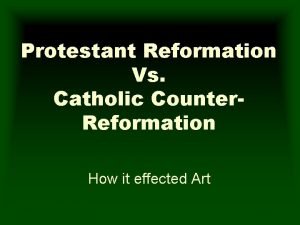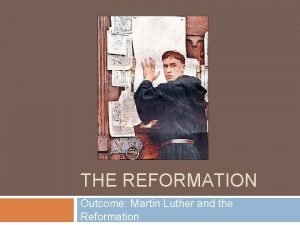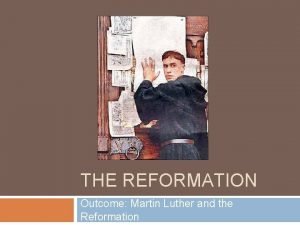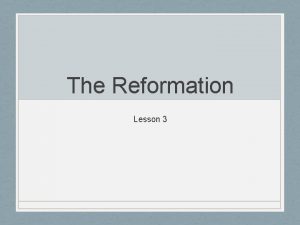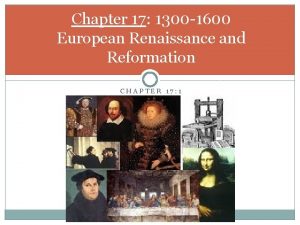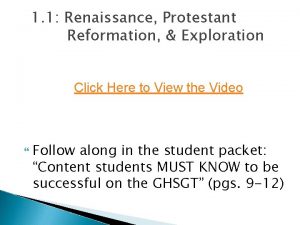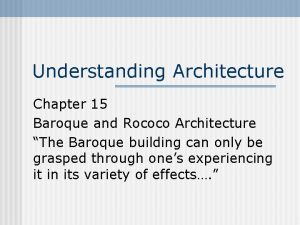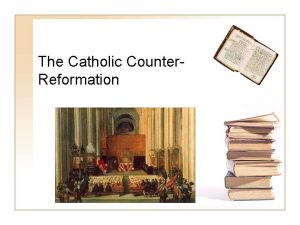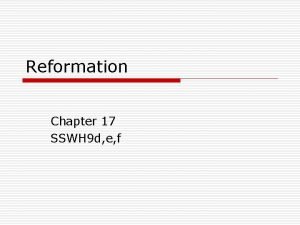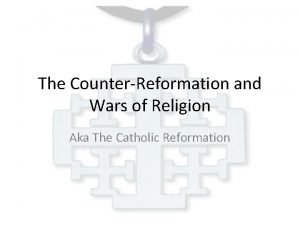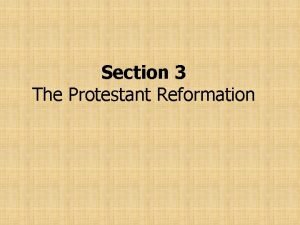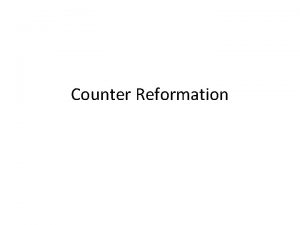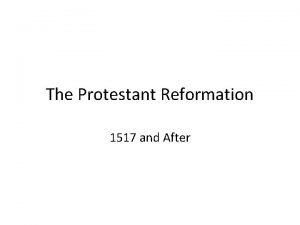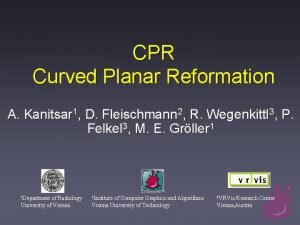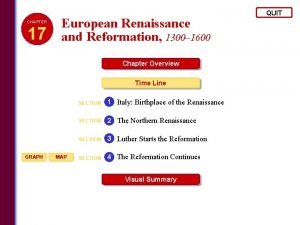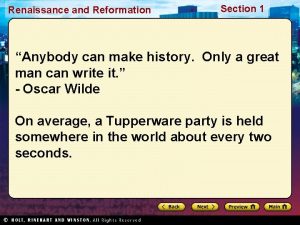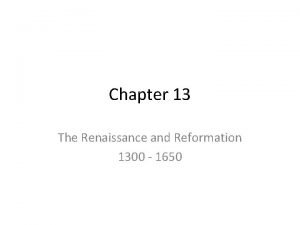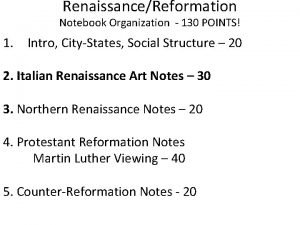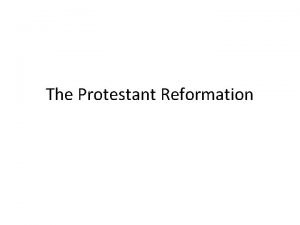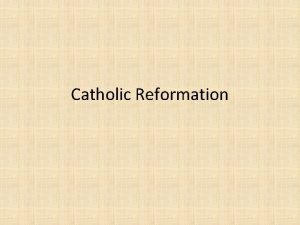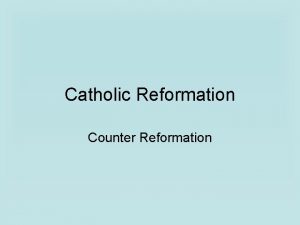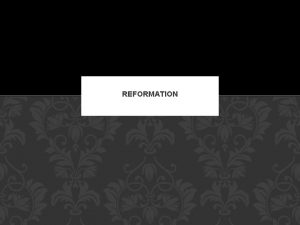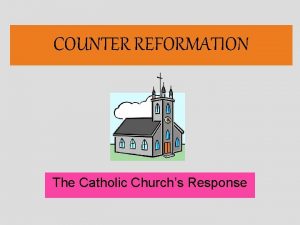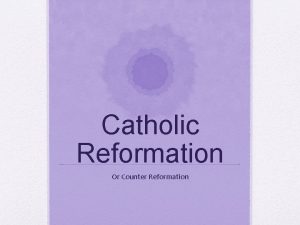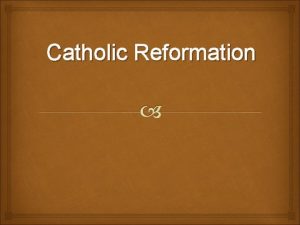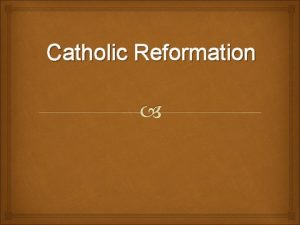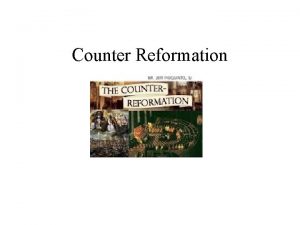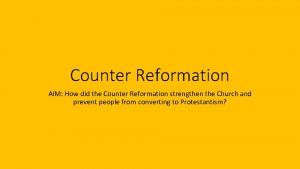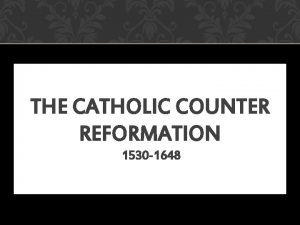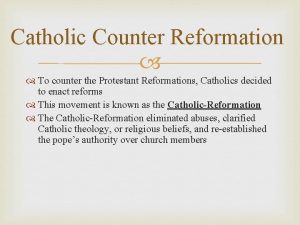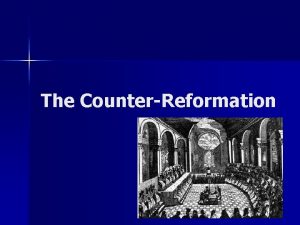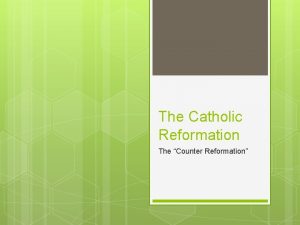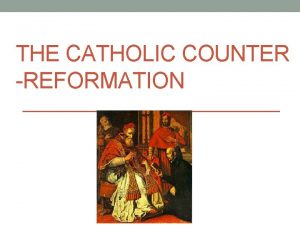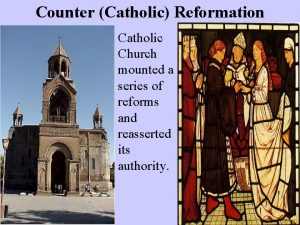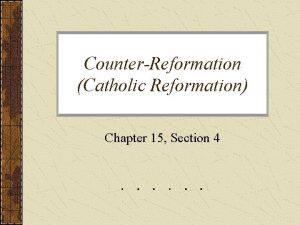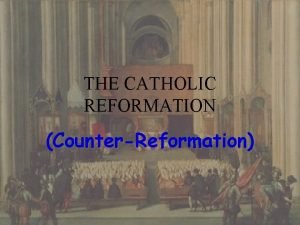The Catholic Counter Reformation The CounterReformation CounterReformation a























- Slides: 23

The Catholic Counter. Reformation

The Counter-Reformation • • • “Counter-Reformation” a term invented by German Protestant historians. Not much liked by Catholic historians, but now generally accepted and used. Phases in papal reaction to Protestantism: 1. 2. 3. Ignoring the problem (up to mid 1530 s) Defensive (up to 1560 s) Forward-looking, proactive (after 1560 s)

The Counter-Reformation • This was both a response to the gains of Protestantism and the repose to critics within the church that abuses needed to be reformed.

Early 16 th century Popes Leo X and the “Luther affair” Adrian VI (1522 -23), Dutch, starts serious reform efforts but dies after just 13 months Clement VII (1523 -34). Great patron of the arts, learning, the Medici family and Florence. No attempts at reform. “He had no more sense than his uncle Leo X of the urgency and magnitude of what was happening in Germany. ”

Paul III (1534 -49), the first “Counter-Reformation” pope Paul III, an “unlikely reformer, an old-fashioned nepotist who as a cardinal had a mistress who bore him four children. ” Viewed the church “as a fortress to be guarded, defended, and kept on the alert”

Paul III (1534 -49) Reinstates the Roman Inquisition – means that “heretics” will go on trial. Public criticism of the church becomes dangerous Approves the Jesuit order in 1540 (more on this soon) And, importantly, convenes the first session of the Council of Trent in 1545

Council of Trent Three sessions: the first two “defensive, ” the last one, from 1561 -63, the most important. Most attendees are Italian bishops.

Council of Trent and Catholic doctrine • Index of Forbidden books strongly enforced • No compromise with Protestant beliefs – i. e. , “If anyone says that by faith alone the impious is justified, let him be anathema. ” • Tradition and the Bible for authority • All seven sacraments are valid, transubstantiation is right, etc. • Idea instead is to “define Catholic teaching much more sharply than it had been before. ” • Theological works of Thomas Aquinas are key

Council of Trent and Catholic doctrine • Equal validity of Scripture, Church traditions and writings of Church fathers • Monasticism, celibacy of the clergy and purgatory reaffirmed • Church abuses such as simony, and the sale of indulgences curtailed

“Tridentine” reforms • Especially important: for the first time, seminaries are established for priests in every diocese. Every priest must be educated. • Bishops are charged to make regular visitations • Did not touch question of papal reform. • No other council called for 300 years!

“In a much stronger sense than before the Reformation, the Catholic Church became Roman Catholic. ”

Jesuits and the Counter-Reformation • Jesuits often called the “shock troops” of the Counter. Reformation. • Extremely dedicated, welleducated, disciplined set of men focused on revival of Catholicism: “indefatigable preachers, great missionaries, and formidable polemicists. ” • They help reconvert southern Germany and Poland to Catholicism

Loyola and the Society of Jesus • Ignatius Loyola (14911556) • Son of poor Basque nobleman, becomes a soldier until wounded at age 30. • Religious conversion as he recovers. • 1522, becomes pilgrim and then goes to a monastery

The Spiritual Exercises • In monastery, has a vision 8 days long! • Spiritual Exercises the result: meant as a devotional handbook for a Christian • One exercise: a month of isolation and self-examination of sin • Published 1548 • The fundamental source of Jesuit spirituality

Loyola and the Society of Jesus • In 1534, Loyola and six friends at the Univ. of Paris vow to go on Crusade against the Turks, but in Venice, cannot find a ship to take them to Palestine • Plan B: go to Rome and dedicate themselves to the pope. So they do. • 1537, Paul III ordains them as priests, and they work preaching and helping people in Rome

Loyola and the Society of Jesus • 1540, Formation of the Society of Jesus • Paul III decides they should be allowed to start a new religious order. • Initial idea: Preachers who are loyal only to the pope • The Jesuit superior general lives in Rome and is elected for life. Much more centralized than the friars, for instance.

The Jesuits • In 1542 oversaw both the Spanish and Italian Inquisitions – Spain: persecution of “Moriscos” (Christian Moors) and Christian Jews who were suspected of backsliding to the original faiths – Italy, Pope Paul IV issued a papal bull accusing Jews of killing Jesus and ordering that Jews be placed in Ghettos in the Papal States – The persecution of Jews throughout Europe increased as a result.

Jesuits as confessors • Some Jesuits become personal confessors to important Catholic rulers, such as the king of France and Holy Roman Emperor • A Catholic kind of throne/altar alliance • To Right: Lamormaini, confessor to emperor Ferdinand II during 30 Years War

Rapid expansion: At death of Loyola in 1556, 1000 Jesuits; in 1566, 3000; in 1600, 8, 500; in 1700, 20, 000

Jesuits and education • Somewhat “accidental, ” not part of the original mission, but quickly becomes very important • Jesuits establish excellent schools across Europe – 144 schools by 1579 – 372 schools by 1615 • Many famous Europeans educated by Jesuits: both Descartes and Voltaire, for instance. • Even Protestants attend.

Jesuits and overseas missions • Jesuits not just in Europe – they go to China, Japan, north and south America, and beyond. • Their letters are often the first European perspectives on other peoples of the globe

Effects? • Will spawn the Baroque art movement – teach in a concrete and emotional way and demonstrate the glory and power of the Catholic Church • Inadvertently will spark the Scientific Revolution - create even more formidable challenges to the Catholic Church's authority and very world-view. Specifically, efforts to reform the Julian calendar may have led to the Church's confrontation with Galileo and with the scientific world in general. (historian James Burke)

• Was the Counter-Reformation successful? • Was the Protestant Reformation successful? • Which one was more successful?
 Protestant reformation vs counter reformation
Protestant reformation vs counter reformation The reformation outcome martin luther and the reformation
The reformation outcome martin luther and the reformation The reformation outcome martin luther and the reformation
The reformation outcome martin luther and the reformation Problems in the catholic church reformation
Problems in the catholic church reformation The catholic reformation lesson 3
The catholic reformation lesson 3 What was the counter-reformation?
What was the counter-reformation? Chapter 15 section 2 world history
Chapter 15 section 2 world history What was the counter-reformation?
What was the counter-reformation? What was the counter-reformation?
What was the counter-reformation? Was the counter reformation successful?
Was the counter reformation successful? Reformation def
Reformation def What was the counter-reformation?
What was the counter-reformation? A major goal of the counter reformation was to
A major goal of the counter reformation was to Counter reformation
Counter reformation Chapter 17 section 4 the reformation continues answer key
Chapter 17 section 4 the reformation continues answer key Protestant reformation map
Protestant reformation map Curved planar reformation
Curved planar reformation European renaissance and reformation
European renaissance and reformation Reformation
Reformation Chapter 13 renaissance and reformation
Chapter 13 renaissance and reformation 3 causes of the reformation
3 causes of the reformation New testament reformation fellowship
New testament reformation fellowship Renaissance and reformation interactive notebook
Renaissance and reformation interactive notebook Ulrich zwingli was a leader of the reformation in ______.
Ulrich zwingli was a leader of the reformation in ______.
